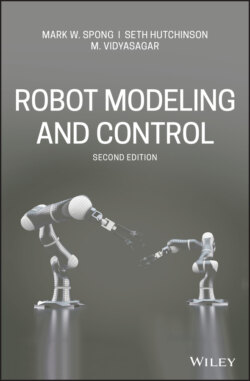Читать книгу Robot Modeling and Control - Mark W. Spong - Страница 38
Chapter 5: Inverse Kinematics
ОглавлениеNow, given the joint angles θ1, θ2 we can determine the end-effector coordinates x and y from Equations (1.1) and (1.2). In order to command the robot to move to location A we need the inverse; that is, we need to solve for the joint variables θ1, θ2 in terms of the x and y coordinates of A. This is the problem of inverse kinematics. Since the forward kinematic equations are nonlinear, a solution may not be easy to find, nor is there a unique solution in general. We can see in the case of a two-link planar mechanism that there may be no solution, for example if the given (x, y) coordinates are out of reach of the manipulator. If the given (x, y) coordinates are within the manipulator’s reach there may be two solutions as shown in Figure 1.21,
Figure 1.21 The two-link elbow robot has two solutions to the inverse kinematics except at singular configurations, the elbow up solution and the elbow down solution.
the so-called elbow up and elbow down configurations, or there may be exactly one solution if the manipulator must be fully extended to reach the point. There may even be an infinite number of solutions in some cases (Problem 1–19).
Consider the diagram of Figure 1.22. Using the law of cosines1 we see that the angle θ2 is given by
Figure 1.22 Solving for the joint angles of a two-link planar arm.
(1.8)
We could now determine θ2 as θ2 = cos − 1(D). However, a better way to find θ2 is to notice that if cos (θ2) is given by Equation (1.8), then sin (θ2) is given as
(1.9)
and, hence, θ2 can be found by
(1.10)
The advantage of this latter approach is that both the elbow-up and elbow-down solutions are recovered by choosing the negative and positive signs in Equation (1.10), respectively.
It is left as an exercise (Problem 1–17) to show that θ1 is now given as
(1.11)
Notice that the angle θ1 depends on θ2. This makes sense physically since we would expect to require a different value for θ1, depending on which solution is chosen for θ2.
